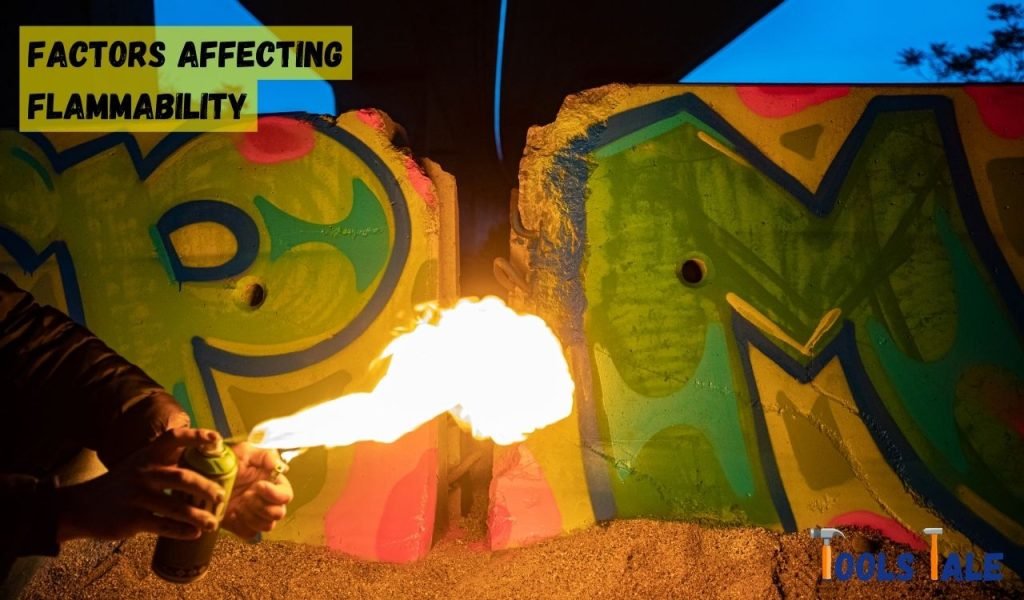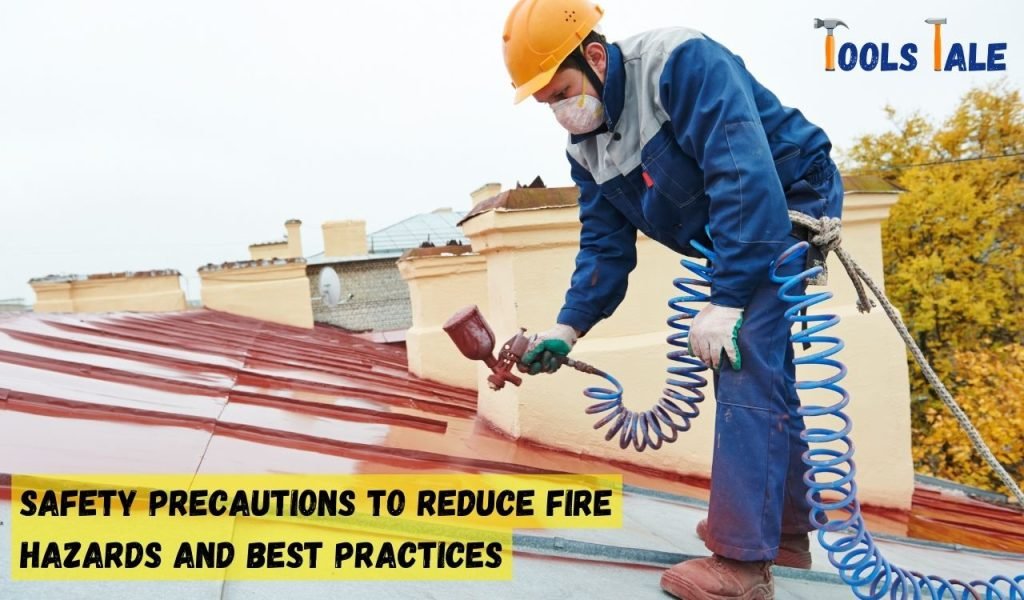Physical Address
304 North Cardinal St.
Dorchester Center, MA 02124
Physical Address
304 North Cardinal St.
Dorchester Center, MA 02124

Is spray paint flammable? Find out the truth about this burning question! Whether you’re a DIY enthusiast or just curious, understanding the flammability of spray paint is essential for your safety. In this guide, we’ll uncover the facts about spray paint’s combustibility and what makes it potentially hazardous. From different paint types to safety precautions, we’ve got you covered.
So, grab your safety goggles and get ready to dive into the world of spray paint flammability. Let’s separate the sparks from the truth and ensure your painting projects stay sizzling without any unexpected flames!
Key Summary: Is Spray Paint Flammable?
Absolutely, spray paint is flammable due to its solvent content like acetone or butane. These substances evaporate quickly and can easily ignite, making spray paint a potential fire risk. Proper ventilation during use and safe storage are crucial precautions to prevent accidents. stay safe!
Spray paint has undoubtedly revolutionized the world of art, DIY projects, and industrial applications. Its versatility and ease of use have made it a favorite tool for creative individuals and professionals alike. However, before you embark on your next spray paint adventure, it’s essential to address a critical question: Is spray paint flammable?
To grasp the concept of flammability, we must delve into the science behind it. Flammability refers to a substance’s ability to ignite and sustain combustion in the presence of an ignition source. When it comes to spray paint, many of these aerosol products contain flammable components, which can pose potential fire hazards.
Before you proceed with your artistic endeavors, it’s crucial to identify whether the spray paint you’re using falls into the flammable category. Manufacturers are obligated to provide clear and concise labeling on their products, indicating their flammability levels. Look out for warning signs such as “Flammable,” “Extremely Flammable,” or “Combustible” on the spray paint cans.
The flammability of spray paint brings with it inherent fire hazards that cannot be overlooked. It’s of utmost importance to comprehend these risks thoroughly in order to safeguard yourself and your surroundings. During the application process, flammable spray paint can potentially ignite if it comes into contact with sparks, open flames, or hot surfaces.
Real-Life Example: Picture this—a passionate DIY enthusiast is giving a wooden shelf a fresh coat of spray paint. Little do they know that their lack of awareness about the flammability of the paint will lead them to leave a nearby candle burning. The result? A small fire breaks out, causing damage to the shelf and nearby items.
To navigate the world of spray paint safety, there are crucial precautions and best practices that one must adhere to:
If the fire risks associated with flammable spray paint concern you, fret not! There are viable and safer alternatives to explore. Consider non-flammable spray paint, water-based paint, or eco-friendly aerosol products that can serve as ideal substitutes for various applications.
Rest assured, regulatory bodies have established guidelines to ensure the safety of spray paint products. These industry standards are designed to protect consumers and users from potential hazards. Seek products that comply with these regulations to make informed and secure choices.

When it comes to understanding the flammability of spray paint, several critical factors come into play. These factors directly influence the potential fire hazards associated with using flammable aerosol products. By exploring these factors, users can make informed decisions, take appropriate safety measures, and minimize the risk of fire incidents. Let’s delve into the key factors affecting the flammability of spray paint:
The chemical composition of spray paint plays a significant role in determining its flammability. Some spray paints contain highly volatile substances that are more prone to igniting. Flammable solvents and propellants in the paint formulation can contribute to an increased risk of fire when exposed to an ignition source.
The flashpoint is a critical factor that directly affects the flammability of spray paint. It refers to the lowest temperature at which the paint can produce enough vapor to ignite in the presence of an ignition source. Paints with lower flashpoints are more susceptible to igniting, making them potentially more hazardous.
The proximity of spray paint to ignition sources significantly influences its flammability. Exposure to open flames, sparks, or hot surfaces can trigger the ignition of flammable aerosol vapors. Therefore, it’s crucial to keep spray paint away from potential ignition sources during storage and application.
The level of ventilation in the area where spray paint is used plays a crucial role in its flammability. Poor ventilation can lead to the accumulation of flammable vapors, increasing the risk of fire incidents during spraying.
Proper storage conditions are essential to maintain the safety of flammable spray paint. Storing aerosol cans in areas with high temperatures or direct sunlight can raise the internal pressure, potentially leading to leaks or bursts.
Spray paint should be kept away from heat sources, such as heaters or electrical appliances, to prevent any unintentional ignition due to elevated temperatures.
The presence of other combustible materials in the vicinity of spray paint usage can add to the fire risk. It’s essential to clear the area of any potential flammable materials before spraying.
Lack of awareness regarding the flammability of spray paint can lead to unsafe practices and increase the likelihood of fire accidents. Understanding the potential risks associated with using flammable spray paint is critical for ensuring safety.

Safety should always be a top priority when working with flammable spray paint. By following essential safety precautions and best practices, users can significantly reduce the risk of fire hazards and ensure a safer environment for their spray paint projects. Let’s explore the key safety measures that should be taken to minimize fire risks:
By adhering to these safety precautions and best practices, individuals can significantly reduce the risk of fire hazards while enjoying the creative possibilities of spray paint. Responsible handling, awareness, and preparedness are key to a safe and enjoyable spray painting experience. Remember, safety should always be the foundation of any artistic endeavor involving flammable materials.
For individuals seeking safer options without compromising on performance and creativity, several alternatives to flammable spray paint are available. These alternatives provide excellent solutions for various projects, ensuring a reduced risk of fire hazards. Let’s explore three popular alternatives:
Non-flammable spray paint is an ideal choice for those who prioritize safety. These products use alternative propellants and solvents that do not pose the same flammability risks as traditional aerosols. Non-flammable spray paint offers ease of application and vibrant color options, making it a reliable choice for artists and DIY enthusiasts.
Water-based spray paint is gaining popularity as an eco-friendly and non-flammable alternative. This type of spray paint utilizes water as its primary solvent, reducing the risk of flammability significantly. In addition to its safety benefits, water-based spray paint tends to have lower volatile organic compound (VOC) emissions, making it an environmentally conscious choice.
As sustainability becomes increasingly important, eco-friendly aerosol products have emerged as a viable alternative to traditional flammable spray paint. These products are designed with a focus on reduced environmental impact, using non-toxic and non-flammable ingredients. Eco-friendly aerosols offer a broad range of colors and finishes, making them suitable for various applications.
When considering alternatives to flammable spray paint, it’s essential to select products that align with your specific needs and project requirements. Whether you opt for non-flammable spray paint, water-based alternatives, or eco-friendly aerosols, these options offer peace of mind and open up a world of creative possibilities without compromising safety.
Spray paint can indeed be flammable, and understanding its potential fire hazards is crucial. By following safety precautions, being aware of ignition sources, and choosing safer alternatives like non-flammable spray paint or water-based options, you can enjoy the artistic freedom spray paint offers without compromising on safety.
Prioritize responsible handling, stay informed about the products you use, and embrace creativity while keeping safety at the forefront of your spray painting journey. Happy and safe spraying!
Yes, spray paint can be flammable. Many aerosol spray paints contain flammable solvents that can catch fire if exposed to an open flame, sparks, or heat sources.
The flammability of spray paint depends on the specific formulation and volatile compounds present. Generally, the flammability risk diminishes as the solvents evaporate after application, but caution should still be exercised until fully dry.
Most aerosol spray paints, including oil-based and enamel varieties, contain flammable solvents. Always check the product label or manufacturer’s information for details on flammability.
Spray paint is typically a liquid contained within an aerosol can. The liquid paint is mixed with propellant gases that allow it to be sprayed, but the flammability mainly comes from the volatile solvents in the liquid.
Spray paint is flammable due to the presence of volatile organic compounds (VOCs) and solvents in its formulation. These substances are highly combustible and can ignite if exposed to heat, flame, or other ignition sources.
Water-based spray paint is generally less flammable than solvent-based options because it uses water as a carrier instead of highly flammable solvents. However, water-based spray paint may still contain some flammable components, so caution is advised.
The permanence of spray paint depends on the type and formulation. Many spray paints are designed to provide a durable and long-lasting finish, but factors like exposure to weather, surface preparation, and protective coatings can affect their longevity.